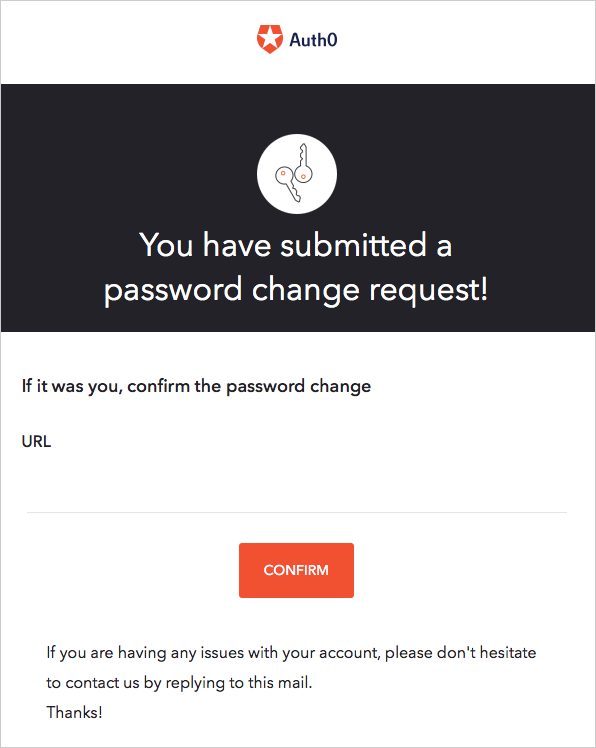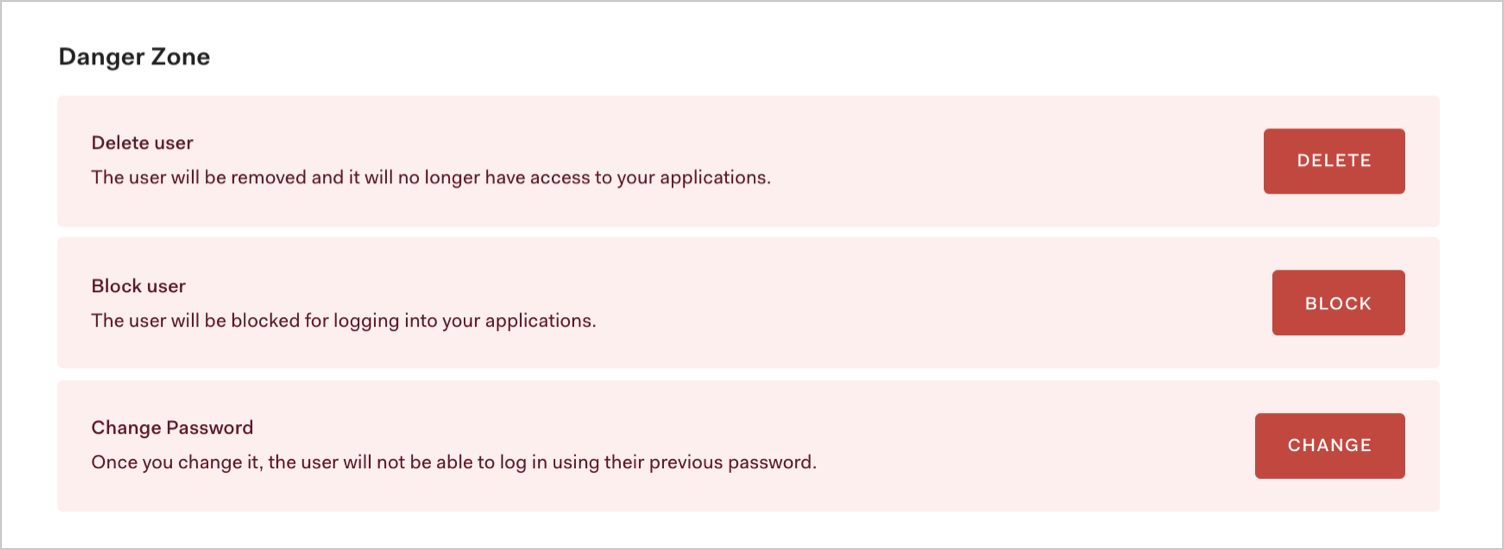Change Users' Passwords
Overview
Key Concepts
Trigger a password reset using Auth0 Dashboard or the Management API.
This topic describes different ways to reset the password for a user in your database. You can change passwords for users in your database connections only. Users signing in with social or enterprise connections must reset their passwords with the identity provider (such as Google or Facebook), and the following instructions work only if the user's email address is known.
There are two basic methods for changing a user's password:
Trigger an interactive password reset flow that sends the user a link through email. The link opens the Auth0 password reset page where the user can enter a new password.
Directly set the new password using the Auth0 Management API or the Auth0 Dashboard.
Not what you're looking for?
To configure the custom Password Reset page, read Customize Password Reset Page.
To implement custom behavior after a successful password change, read Actions Triggers: post-change-password.
To reset the password to your personal Auth0 user account, read Reset Account Passwords.
Trigger an interactive password reset flow
There are two ways to trigger an interactive password reset flow, depending on your use case: through the Universal Login page or the Authentication API.
Universal Login page
If your application uses Universal Login, the user can use the Lock widget on the Login screen to trigger a password reset email. With Universal Login, the user can click the Don't remember your password? link and then enter their email address. This fires off a POST request to Auth0 that triggers the password reset process. The user receives a password reset email.
Authentication API
If your application uses an interactive password reset flow through the Authentication API, make a POST call. In the email field, provide the email address of the user who needs to change their password. If the call is successful, the user receives a password reset email.
If you call the API from the browser, be sure the origin URL is allowed:
Go to Auth0 Dashboard > Applications > Applications, and add the URL to the Allowed Origins (CORS) list.
If your connection is a custom database, check to see if the user exists in the database before you invoke the Authentication API for changePassword.
curl --request POST \
--url 'https://{yourDomain}/dbconnections/change_password' \
--header 'content-type: application/json' \
--data '{"client_id": "{yourClientId}","email": "","connection": "Username-Password-Authentication"}'Was this helpful?
var client = new RestClient("https://{yourDomain}/dbconnections/change_password");
var request = new RestRequest(Method.POST);
request.AddHeader("content-type", "application/json");
request.AddParameter("application/json", "{\"client_id\": \"{yourClientId}\",\"email\": \"\",\"connection\": \"Username-Password-Authentication\"}", ParameterType.RequestBody);
IRestResponse response = client.Execute(request);Was this helpful?
package main
import (
"fmt"
"strings"
"net/http"
"io/ioutil"
)
func main() {
url := "https://{yourDomain}/dbconnections/change_password"
payload := strings.NewReader("{\"client_id\": \"{yourClientId}\",\"email\": \"\",\"connection\": \"Username-Password-Authentication\"}")
req, _ := http.NewRequest("POST", url, payload)
req.Header.Add("content-type", "application/json")
res, _ := http.DefaultClient.Do(req)
defer res.Body.Close()
body, _ := ioutil.ReadAll(res.Body)
fmt.Println(res)
fmt.Println(string(body))
}Was this helpful?
HttpResponse<String> response = Unirest.post("https://{yourDomain}/dbconnections/change_password")
.header("content-type", "application/json")
.body("{\"client_id\": \"{yourClientId}\",\"email\": \"\",\"connection\": \"Username-Password-Authentication\"}")
.asString();Was this helpful?
var axios = require("axios").default;
var options = {
method: 'POST',
url: 'https://{yourDomain}/dbconnections/change_password',
headers: {'content-type': 'application/json'},
data: {
client_id: '{yourClientId}',
email: '',
connection: 'Username-Password-Authentication'
}
};
axios.request(options).then(function (response) {
console.log(response.data);
}).catch(function (error) {
console.error(error);
});Was this helpful?
#import <Foundation/Foundation.h>
NSDictionary *headers = @{ @"content-type": @"application/json" };
NSDictionary *parameters = @{ @"client_id": @"{yourClientId}",
@"email": @"",
@"connection": @"Username-Password-Authentication" };
NSData *postData = [NSJSONSerialization dataWithJSONObject:parameters options:0 error:nil];
NSMutableURLRequest *request = [NSMutableURLRequest requestWithURL:[NSURL URLWithString:@"https://{yourDomain}/dbconnections/change_password"]
cachePolicy:NSURLRequestUseProtocolCachePolicy
timeoutInterval:10.0];
[request setHTTPMethod:@"POST"];
[request setAllHTTPHeaderFields:headers];
[request setHTTPBody:postData];
NSURLSession *session = [NSURLSession sharedSession];
NSURLSessionDataTask *dataTask = [session dataTaskWithRequest:request
completionHandler:^(NSData *data, NSURLResponse *response, NSError *error) {
if (error) {
NSLog(@"%@", error);
} else {
NSHTTPURLResponse *httpResponse = (NSHTTPURLResponse *) response;
NSLog(@"%@", httpResponse);
}
}];
[dataTask resume];Was this helpful?
$curl = curl_init();
curl_setopt_array($curl, [
CURLOPT_URL => "https://{yourDomain}/dbconnections/change_password",
CURLOPT_RETURNTRANSFER => true,
CURLOPT_ENCODING => "",
CURLOPT_MAXREDIRS => 10,
CURLOPT_TIMEOUT => 30,
CURLOPT_HTTP_VERSION => CURL_HTTP_VERSION_1_1,
CURLOPT_CUSTOMREQUEST => "POST",
CURLOPT_POSTFIELDS => "{\"client_id\": \"{yourClientId}\",\"email\": \"\",\"connection\": \"Username-Password-Authentication\"}",
CURLOPT_HTTPHEADER => [
"content-type: application/json"
],
]);
$response = curl_exec($curl);
$err = curl_error($curl);
curl_close($curl);
if ($err) {
echo "cURL Error #:" . $err;
} else {
echo $response;
}Was this helpful?
import http.client
conn = http.client.HTTPSConnection("")
payload = "{\"client_id\": \"{yourClientId}\",\"email\": \"\",\"connection\": \"Username-Password-Authentication\"}"
headers = { 'content-type': "application/json" }
conn.request("POST", "/{yourDomain}/dbconnections/change_password", payload, headers)
res = conn.getresponse()
data = res.read()
print(data.decode("utf-8"))Was this helpful?
require 'uri'
require 'net/http'
require 'openssl'
url = URI("https://{yourDomain}/dbconnections/change_password")
http = Net::HTTP.new(url.host, url.port)
http.use_ssl = true
http.verify_mode = OpenSSL::SSL::VERIFY_NONE
request = Net::HTTP::Post.new(url)
request["content-type"] = 'application/json'
request.body = "{\"client_id\": \"{yourClientId}\",\"email\": \"\",\"connection\": \"Username-Password-Authentication\"}"
response = http.request(request)
puts response.read_bodyWas this helpful?
import Foundation
let headers = ["content-type": "application/json"]
let parameters = [
"client_id": "{yourClientId}",
"email": "",
"connection": "Username-Password-Authentication"
] as [String : Any]
let postData = JSONSerialization.data(withJSONObject: parameters, options: [])
let request = NSMutableURLRequest(url: NSURL(string: "https://{yourDomain}/dbconnections/change_password")! as URL,
cachePolicy: .useProtocolCachePolicy,
timeoutInterval: 10.0)
request.httpMethod = "POST"
request.allHTTPHeaderFields = headers
request.httpBody = postData as Data
let session = URLSession.shared
let dataTask = session.dataTask(with: request as URLRequest, completionHandler: { (data, response, error) -> Void in
if (error != nil) {
print(error)
} else {
let httpResponse = response as? HTTPURLResponse
print(httpResponse)
}
})
dataTask.resume()Was this helpful?
Password reset email
Regardless of how the password reset process was triggered, the user receives email containing a link to reset their password.

Clicking the link sends the user to the password reset page.
After submitting the new password, the user sees confirmation that they can now log in with their new credentials.
Notes on password resets:
The reset password link in the email is valid for one use only.
If the user receives multiple password reset emails, only the password link in the most recent email is valid.
The URL Lifetime field determines how long the link is valid. From the Auth0 dashboard, you can customize the Change Password email and modify the link's lifetime.
You can extend the password reset flow to include another factor with Auth0 Actions. To learn more, read Password Reset Flow.
With Classic Login, you can configure a URL to redirect users to after completing the password reset. The URL receives a success indicator and a message. To learn more, read the "Configuring the Redirect-To URL" section in Customize Email Templates.
Universal Login redirects the user to the default login route when it succeeds, and handles the error cases as part of the Universal Login flow. This experience ignores the Redirect URL in the email template.
Generate Password Reset tickets
The Management API provides the Create a Password Change Ticket endpoint, which generates a URL like the one in the password reset email. You can use the generated URL when the email delivery method is not appropriate. Keep in mind that in the default flow, the email delivery verifies the identity of the user. (An impostor wouldn't have access to the email inbox.) If you use the ticket URL, your application is responsible for verifying the identity of the user in some other way.
Directly set the new password
To directly set a new password for the user without sending a password reset email, use either the Management API or the Auth0 Dashboard.
Use the Management API
If you want to implement your own password reset flow, you can directly change a user's password from a server request to the Management API: make a PATCH call to the Update a User endpoint.
curl --request PATCH \
--url 'https://{yourDomain}/api/v2/users/%7BuserId%7D' \
--header 'authorization: Bearer {yourMgmtApiAccessToken}' \
--header 'content-type: application/json' \
--data '{"password": "newPassword","connection": "connectionName"}'Was this helpful?
var client = new RestClient("https://{yourDomain}/api/v2/users/%7BuserId%7D");
var request = new RestRequest(Method.PATCH);
request.AddHeader("content-type", "application/json");
request.AddHeader("authorization", "Bearer {yourMgmtApiAccessToken}");
request.AddParameter("application/json", "{\"password\": \"newPassword\",\"connection\": \"connectionName\"}", ParameterType.RequestBody);
IRestResponse response = client.Execute(request);Was this helpful?
package main
import (
"fmt"
"strings"
"net/http"
"io/ioutil"
)
func main() {
url := "https://{yourDomain}/api/v2/users/%7BuserId%7D"
payload := strings.NewReader("{\"password\": \"newPassword\",\"connection\": \"connectionName\"}")
req, _ := http.NewRequest("PATCH", url, payload)
req.Header.Add("content-type", "application/json")
req.Header.Add("authorization", "Bearer {yourMgmtApiAccessToken}")
res, _ := http.DefaultClient.Do(req)
defer res.Body.Close()
body, _ := ioutil.ReadAll(res.Body)
fmt.Println(res)
fmt.Println(string(body))
}Was this helpful?
HttpResponse<String> response = Unirest.patch("https://{yourDomain}/api/v2/users/%7BuserId%7D")
.header("content-type", "application/json")
.header("authorization", "Bearer {yourMgmtApiAccessToken}")
.body("{\"password\": \"newPassword\",\"connection\": \"connectionName\"}")
.asString();Was this helpful?
var axios = require("axios").default;
var options = {
method: 'PATCH',
url: 'https://{yourDomain}/api/v2/users/%7BuserId%7D',
headers: {
'content-type': 'application/json',
authorization: 'Bearer {yourMgmtApiAccessToken}'
},
data: {password: 'newPassword', connection: 'connectionName'}
};
axios.request(options).then(function (response) {
console.log(response.data);
}).catch(function (error) {
console.error(error);
});Was this helpful?
#import <Foundation/Foundation.h>
NSDictionary *headers = @{ @"content-type": @"application/json",
@"authorization": @"Bearer {yourMgmtApiAccessToken}" };
NSDictionary *parameters = @{ @"password": @"newPassword",
@"connection": @"connectionName" };
NSData *postData = [NSJSONSerialization dataWithJSONObject:parameters options:0 error:nil];
NSMutableURLRequest *request = [NSMutableURLRequest requestWithURL:[NSURL URLWithString:@"https://{yourDomain}/api/v2/users/%7BuserId%7D"]
cachePolicy:NSURLRequestUseProtocolCachePolicy
timeoutInterval:10.0];
[request setHTTPMethod:@"PATCH"];
[request setAllHTTPHeaderFields:headers];
[request setHTTPBody:postData];
NSURLSession *session = [NSURLSession sharedSession];
NSURLSessionDataTask *dataTask = [session dataTaskWithRequest:request
completionHandler:^(NSData *data, NSURLResponse *response, NSError *error) {
if (error) {
NSLog(@"%@", error);
} else {
NSHTTPURLResponse *httpResponse = (NSHTTPURLResponse *) response;
NSLog(@"%@", httpResponse);
}
}];
[dataTask resume];Was this helpful?
$curl = curl_init();
curl_setopt_array($curl, [
CURLOPT_URL => "https://{yourDomain}/api/v2/users/%7BuserId%7D",
CURLOPT_RETURNTRANSFER => true,
CURLOPT_ENCODING => "",
CURLOPT_MAXREDIRS => 10,
CURLOPT_TIMEOUT => 30,
CURLOPT_HTTP_VERSION => CURL_HTTP_VERSION_1_1,
CURLOPT_CUSTOMREQUEST => "PATCH",
CURLOPT_POSTFIELDS => "{\"password\": \"newPassword\",\"connection\": \"connectionName\"}",
CURLOPT_HTTPHEADER => [
"authorization: Bearer {yourMgmtApiAccessToken}",
"content-type: application/json"
],
]);
$response = curl_exec($curl);
$err = curl_error($curl);
curl_close($curl);
if ($err) {
echo "cURL Error #:" . $err;
} else {
echo $response;
}Was this helpful?
import http.client
conn = http.client.HTTPSConnection("")
payload = "{\"password\": \"newPassword\",\"connection\": \"connectionName\"}"
headers = {
'content-type': "application/json",
'authorization': "Bearer {yourMgmtApiAccessToken}"
}
conn.request("PATCH", "/{yourDomain}/api/v2/users/%7BuserId%7D", payload, headers)
res = conn.getresponse()
data = res.read()
print(data.decode("utf-8"))Was this helpful?
require 'uri'
require 'net/http'
require 'openssl'
url = URI("https://{yourDomain}/api/v2/users/%7BuserId%7D")
http = Net::HTTP.new(url.host, url.port)
http.use_ssl = true
http.verify_mode = OpenSSL::SSL::VERIFY_NONE
request = Net::HTTP::Patch.new(url)
request["content-type"] = 'application/json'
request["authorization"] = 'Bearer {yourMgmtApiAccessToken}'
request.body = "{\"password\": \"newPassword\",\"connection\": \"connectionName\"}"
response = http.request(request)
puts response.read_bodyWas this helpful?
import Foundation
let headers = [
"content-type": "application/json",
"authorization": "Bearer {yourMgmtApiAccessToken}"
]
let parameters = [
"password": "newPassword",
"connection": "connectionName"
] as [String : Any]
let postData = JSONSerialization.data(withJSONObject: parameters, options: [])
let request = NSMutableURLRequest(url: NSURL(string: "https://{yourDomain}/api/v2/users/%7BuserId%7D")! as URL,
cachePolicy: .useProtocolCachePolicy,
timeoutInterval: 10.0)
request.httpMethod = "PATCH"
request.allHTTPHeaderFields = headers
request.httpBody = postData as Data
let session = URLSession.shared
let dataTask = session.dataTask(with: request as URLRequest, completionHandler: { (data, response, error) -> Void in
if (error != nil) {
print(error)
} else {
let httpResponse = response as? HTTPURLResponse
print(httpResponse)
}
})
dataTask.resume()Was this helpful?
Manually set users' passwords using the Auth0 Dashboard
Anyone with administrative privileges to your Auth0 tenant can manually change a user's password at Auth0 Dashboard > User Management > Users.
Select the name of the user whose password you want to change.
Locate the Danger Zone at the bottom of the page.
In the red Change Password box, select Change.

Enter the new password, and select Save.
